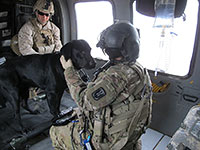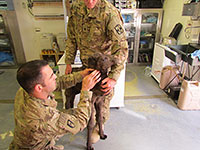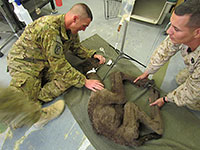Caring for Military Working Dogs in Afghanistan
Capt. Sean McPeck graduated from University of Houston with a B.S. in biology in 2005. He earned his D.V.M. at Colorado State University’s College of Veterinary Medicine and Biomedical Sciences in 2010. From July 2011 to June 2012, he ran the veterinary clinic at Camp Dwyer, Afghanistan, providing care to the Military Working Dogs in the Southern Helmand Province. He is now stationed at Fort Benning, Georgia.
What is the most interesting thing you learned while caring for Military Working Dogs (MWDs)?
One of the most interesting things I learned working with MWDs is the extent of the duties they are trained to perform. Many are dual certified. From finding drugs and explosives to man-tracking and guarding, these canine warriors go anywhere and everywhere the human warriors do. The MWDs are parachuting, doing water operations, and going to every environment on Earth where the military goes. From the deserts of Iraq and Afghanistan to the extreme winter conditions of mountainous environments in Europe and North America, these dogs go everywhere.
What types of dogs serve as MWDs?
Many Labradors are in the Improvised Explosive Detector (IED) Dogs program in the Marines. The Army usually uses German Shepherds and Belgian Malinois that are often used as dual certified dogs with a Bite, Guard, and Explosive and Drug Search combo.
Aside from treating injured MWDs, what is the routine health care schedule of the MWDs?
MWDs are on a strict medical care program. Each one goes through a semi-annual and annual exam. Everything from blood work and dentals, to radiographs are completed to ensure these valuable creatures are well cared for. As a veterinarian, I rely heavily on the aptitude of the MWD handlers. If the handlers are not in tune with their dogs, then that is when we see the dogs suffer.
Every military branch has different MWD handlers performing different duties. There is a direct correlation between the amount of training the handlers go through and the care of the dogs. Some organizations only require their handlers to go through about three weeks of dog training. Others are required to complete up to a year of dog handling instruction. The health of the dogs is directly related to the amount of care and attention the handler provides.
What were some of the weekly and monthly aspects of your job when you were in Afghanistan?
- MEDEVACs and Walk-Ins
 In Afghanistan, a typical week included one or two MEDEVACs. I saw everything from IED blasts and gunshot wounds, to snake bites and severe gastrointestinal issues from drinking water in the local Afghan area. The canine warriors get MEDEVAC’d on the helicopters right next to their human service members. The MEDEVAC personnel were always getting trained and equipped by the Army veterinarians to ensure they were on top of their game since were the first responders. We saw a lot of walk-ins when the handlers had questions or concerns, either in preparation for upcoming missions or suspecting something needed attention. Most of all, I saw gastrointestinal and skin issues. In Afghanistan, a typical week included one or two MEDEVACs. I saw everything from IED blasts and gunshot wounds, to snake bites and severe gastrointestinal issues from drinking water in the local Afghan area. The canine warriors get MEDEVAC’d on the helicopters right next to their human service members. The MEDEVAC personnel were always getting trained and equipped by the Army veterinarians to ensure they were on top of their game since were the first responders. We saw a lot of walk-ins when the handlers had questions or concerns, either in preparation for upcoming missions or suspecting something needed attention. Most of all, I saw gastrointestinal and skin issues.
- Human Food Safety and Inspection
In the Army, veterinary teams also cover food safety and inspection, so part of my job was to ensure that there had been no tampering or attempts to contaminate the food for service members. Since we worked in an extreme environment, with temperatures reaching 140+ in the sun, the food could perish quickly. We did not have the luxury of tossing all expired food, so it was the veterinarians’ duty to see if food items could be extended to save the government money and ensure that the service men and women still had access to certain products without having to wait months on a resupply.
- Training Human Care Providers

McPeck demonstrating location of jugular to human care medics.I also instructed human care providers on first aid for MWDs, from the MEDEVAC and pararescue personnel to the physicians in the hospital. If other service members around the MWDs understood what to do in an emergency, it ensured that the dogs would have a higher chance of survival.
- Kennel Inspections
I conducted kennel inspections once a month to make sure the dogs were treated properly and their living conditions were good. I traveled to outlying operating bases to evaluate the service members’ food and water and did inspections on the MWD kennels. Travel was mostly by helicopter, but I also traveled by convoy. My area of operation was the Southern Helmand Province. This area was pretty intense with a lot of activity; there was never a dull moment.
What was your most memorable experience?
 The most memorable moment was saving a newborn, wild Dromedarian camel. She got separated from her herd and wandered through our perimeters. The Marines on perimeter security notified me, and by the time she was brought to me, she was dehydrated and pretty weak. I placed an IV jugular catheter and gave her some fluids with dextrose. I was also able to get her to suckle from the finger of a latex glove that I filled with soy milk. The most memorable moment was saving a newborn, wild Dromedarian camel. She got separated from her herd and wandered through our perimeters. The Marines on perimeter security notified me, and by the time she was brought to me, she was dehydrated and pretty weak. I placed an IV jugular catheter and gave her some fluids with dextrose. I was also able to get her to suckle from the finger of a latex glove that I filled with soy milk.  The Marines where excited to assist me in locating her herd and used an unmanned aerial vehicle (UAV) that was already airborne to spot her herd about 1,000 meters from our location. We put together a convoy with the Marines and Jordanians to rejoin the young camel with her mother. I thought this was a great example of a multinational effort to conserve the valuable local Afghan wildlife. It was also very rewarding as I usually had to euthanize most of the local animals that were brought to me. The Marines where excited to assist me in locating her herd and used an unmanned aerial vehicle (UAV) that was already airborne to spot her herd about 1,000 meters from our location. We put together a convoy with the Marines and Jordanians to rejoin the young camel with her mother. I thought this was a great example of a multinational effort to conserve the valuable local Afghan wildlife. It was also very rewarding as I usually had to euthanize most of the local animals that were brought to me.
How about the downside of the job?
The wild animal euthanasia was the downside of the job. I worked closely with Vector Control which is a civilian contracted job. They would live trap and catch any wild or feral animals that came into our camp and bring them to me. I would ensure they weren’t an endangered species and then have to humanely euthanize them. I would often have to take away and euthanize puppies and kittens that young Soldiers and Marines would secretly adopt. Since rabies is extremely prevalent in that area, the service members had to be protected by us, even when they didn’t understand they were in danger. It’s the silent killers that impact our fighting force the most. If you look at any major engagement, the non-battle injuries and diseases are what impact us the most. It takes a toll on you after awhile, especially when you just want to save the animals, but you try to focus on the big picture and what we are trying to achieve. We want to come home healthy and ensure our service members come home healthy also.
When did you decide to become a veterinarian?
I remember always wanting to be a veterinarian. Even as a young child, I knew that I wanted to take care of animals. I’ve always had a compassion for animals, both wild and domestic, and knew that I wanted to spend my life working with animals or studying them.
How did you decide to join the military?
I graduated from high school in Anchorage, Alaska, and bought a ticket out of Alaska to begin hitchhiking through the Midwest. I had a strong desire for exploration and adventure. After six months, I decided I wanted to be an Airborne Ranger and enlisted in the Army in 1996 to go through Ranger Selection. I was selected and joined 3rd Ranger Battalion where I spent the next four years becoming a Sniper Team Leader and a Sergeant. I decided to pursue my education and began my bachelor’s degree in biology while I was still with the Army National Guard. I was with a Long Range Surveillance Detachment (Airborne) and 5th/19th Special Forces Group National Guard units while I pursued my education. After my first year in veterinary school, I found out about scholarships that were available if I returned to active duty. I thought it was a great opportunity, especially since I was already familiar with the military lifestyle. My first duty assignment was with a deployable veterinary unit supporting Operation Enduring Freedom for 12 months.
What are some highlights of your undergraduate years?
I spent my undergraduate years looking for adventures that benefitted my ultimate goal of becoming a veterinarian. I did a study abroad to Madagascar and ended up helping researchers dart lemurs for conservation studies. I had no idea that my marksmanship training in the Army Special Operations would eventually be used to conserve and study wildlife. Researchers from Duke University and Johns Hopkins University also invited me on multiple occasions to work in Costa Rica darting howler and spider monkeys. From 2002-2005, I was Battalion Commander for the UH ROTC and President of the UH Mixed Martial Arts Club.
What do you plan to do when you leave the Army?
I've always wanted to be a part of a community and run the local veterinary clinic. I want to be that family vet that sees the family get their puppy and give it their first shots, and be there until the dog is old and grey. I have one year left on Active Duty and will be looking to join a clinic somewhere with the eventual goal of starting my own practice. However, I love adventure and have always dreamed of other careers that have nothing to do with veterinary medicine. I honestly just want to be happy when I wake up, regardless of what I’m doing. |

